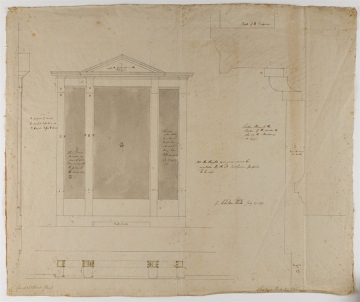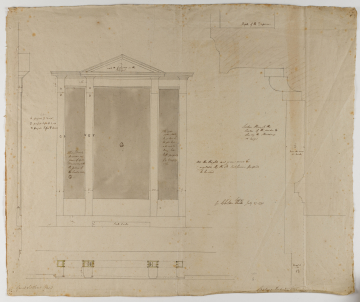
Browse
Reference number
Purpose
Aspect
Scale
Inscribed
Signed and dated
- Great Scotland Yard and Copy July 27 1791 (and dated again as above)
Medium and dimensions
Hand
Notes
Drawings 1 and 3 show several pedimented tripartite windows together with a single-light version. In those drawing, the pediments are the full width of the window and the mouldings are plain (square-cut). Both types have an arresting detail which is a 12 x 5 inches plain 'triglyph'. However, the working drawing catalogued here modifies the details so that the centre opening of a tripartite window has a moulded pediment and each pilaster has a vestigial capital - the starker and more Soanean design is lost.
Soane's office Day Book for 27 and 28 July 1791 has an entry by Meyers 'Copying working drawing / of Venetian Window to / Chilton lodge' . Thus the office retained the drawing by Soane and a copy was dispatched to the builder; an entry for the following day has 'Mr Morland / Left at Mr Piper's a / drawing & Section of / the Venetian Window / to Chilton Lodge'.
Level
Sir John Soane's collection includes some 30,000 architectural, design and topographical drawings which is a very important resource for scholars worldwide. His was the first architect’s collection to attempt to preserve the best in design for the architectural profession in the future, and it did so by assembling as exemplars surviving drawings by great Renaissance masters and by the leading architects in Britain in the 17th and 18th centuries and his near contemporaries such as Sir William Chambers, Robert Adam and George Dance the Younger. These drawings sit side by side with 9,000 drawings in Soane’s own hand or those of the pupils in his office, covering his early work as a student, his time in Italy and the drawings produced in the course of his architectural practice from 1780 until the 1830s.
Browse (via the vertical menu to the left) and search results for Drawings include a mixture of Concise catalogue records – drawn from an outline list of the collection – and fuller records where drawings have been catalogued in more detail (an ongoing process).




